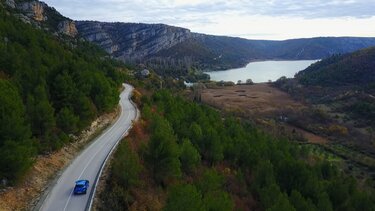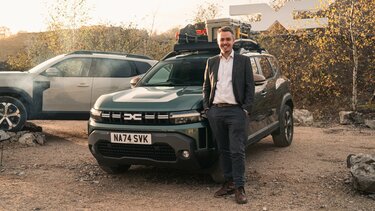Dacia: The brand that thinks big
14/06/2021
- First created in 1968, Dacia was acquired by Renault Group in 1999
- Its journey has been one of growth with a unique recipe for success
- More than seven million global customers enjoy essential cars at the best price
- Dacia is now preparing for the next chapter in its exciting story
From its creation in 1968, Dacia has grown to become a truly international brand. Since Renault Group acquired it in 1999,
its successful philosophy remains the same – offering the essential at the best price.
Now present in 44 countries and with over seven million customers, Dacia has always adapted to the times and has no intention of standing still. In a world that is increasingly complex, the brand continues to appeal to its vast audience that has opted for a simpler and more straightforward way of life.
Once upon a time in Romania
Dacia was born with one clear objective: to provide modern, robust, and economical cars for all Romanians. Its name is
directly inspired by the name of the territory of present-day Romania, which in ancient times was called “Dacia”.
Gabriel Sorescu, Product Manager at Dacia UK, is someone who lives and breathes the Dacia brand. As a Romanian native with a colourful history of owning Dacia models, including a 1970s Dacia 1300 to his current Duster, Gabriel shares his experiences of the brand. He said:
“My first Dacia was very basic. It was just me and the car, but it represented freedom and spontaneity. Dacias were everywhere in Romania growing up, and having my first one made me discover my love for cars.”
In 1999, guided by Louis Schweitzer, Dacia joined Renault Group. A few years later, in 2004, the next chapter of Dacia was born with the launch of the Logan. Initially designed for emerging markets, the modern, robust and, above all, accessible family saloon sold at an unbeatable price of 5,000 euros. It became a huge commercial success in western
Europe, revolutionising the car market by offering a new vehicle for the price of a used car.
Gabriel, who also owned a Logan, said: “The Logan was the car that really made me realise Dacia had taken a huge step forward. I had mine (my third Dacia at this point) for seven years – it was reliable, economical – not even a single fault or breakdown. I just changed the oil and filters and was always ready to drive. It made it easy to understand why Dacia had become so popular around the world so quickly.”
The Sandero arrived in 2008 as Dacia’s second major launch under Renault Group. It has gone on to become Dacia’s biggest success story to date thanks to its unbeatable blend of practicality and value for money. Sandero is Europe’s number one car for private sales.
In 2010, Dacia broke the rules once again, this time offering the most affordable SUV on the market – the Duster. An attractive vehicle with true go-anywhere capabilities at an accessible price. The rugged and robust SUV was another hit.
In 2013, Dacia made a strong entrance to the UK market with the second-generation Sandero – arriving as the UK’s cheapest new car on sale – available alongside the Sandero Stepway and Duster to offer a completely new proposition to British buyers.
The story continues with a revolution currently underway with the Spring, the lowest-priced electric car on the European market. Dacia has broken the mould with this new car, bringing electric mobility within everyone’s reach.
Over the years, the brand has been able to adapt to its customers’ needs, whilst offering a unique proposition that resonates with the times. Gabriel commented:
“There’s something in the Dacia DNA that makes customers really love their cars, with a strong community who love to come together.”
Dacia today and tomorrow
From design to sale, via manufacturing and transport, the brand remains faithful to its strategy of optimising costs at every step, so that its customers pay only for what they need.
The brand’s ambition is to conquer new territory – particularly the C-segment – based on a unique and effective business model, with a wider range that continues to focus on essential customer needs. The Bigster Concept, unveiled in January 2021 at the presentation of the Renaulution strategic plan, will lead this charge.
Denis Le Vot, CEO Dacia and LADA brands said:
“Dacia will always be Dacia and will continue to offer reliable models that make sense to the customers, a smart purchase that gives best value for money. With the creation of the Dacia/LADA business unit, we will make the most of the CMF-B modular platform, increase our efficiency and improve the quality, competitiveness, and appeal of our products further. We have everything to hand to reach the highest peaks. The Bigster Concept shows us the way.”
With the Bigster Concept, Dacia will be even more attractive, more adventurous, yet still accessible and focused on offering the essential for an SUV of its segment. It makes bold choices with untreated recycled materials for the external protective trim, simple lines and robust proportions. Dacia is becoming a byword for escape as its customers have the chance of unique, real, and uncomplicated experiences.
Gabriel commented: “Even back in my student days we’d take spontaneous road trips to the mountains. It took all day, but it was an adventure. On one trip I even met my best half, and my Dacia became a significant part in the story of my life there and then. I think that attachment to Dacias still resonates with buyers today – they feel that their cars are part of the family. Back in Romania customers were very loyal to Dacia, and I’m happy this quality has translated to other markets, and what Dacia stands for is continuing to strike a chord.”
To embody its brand vision, Dacia is readying itself to write a new chapter in its history with a completely new visual identity. One that offers freedom, authenticity and to reconnect with our environment and share simple pleasures with those closest to us.







